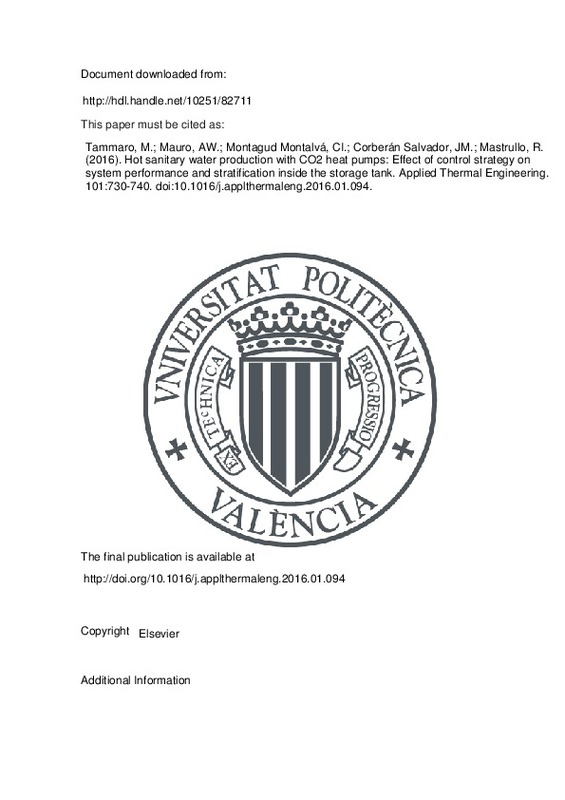JavaScript is disabled for your browser. Some features of this site may not work without it.
Buscar en RiuNet
Listar
Mi cuenta
Estadísticas
Ayuda RiuNet
Admin. UPV
Hot sanitary water production with CO2 heat pumps: Effect of control strategy on system performance and stratification inside the storage tank
Mostrar el registro sencillo del ítem
Ficheros en el ítem
| dc.contributor.author | Tammaro, Marcello
|
es_ES |
| dc.contributor.author | Mauro, A. W.
|
es_ES |
| dc.contributor.author | Montagud Montalvá, Carla Isabel
|
es_ES |
| dc.contributor.author | Corberán Salvador, José Miguel
|
es_ES |
| dc.contributor.author | Mastrullo, R.
|
es_ES |
| dc.date.accessioned | 2017-06-13T09:00:11Z | |
| dc.date.available | 2017-06-13T09:00:11Z | |
| dc.date.issued | 2016-05-25 | |
| dc.identifier.issn | 1359-4311 | |
| dc.identifier.uri | http://hdl.handle.net/10251/82711 | |
| dc.description.abstract | [EN] In this work three different control strategies for the production of sanitary hot water by means of an electric heat pump working with CO2 are investigated. The heat pump is a prototype, here modelled in the vapour-compression software package IMST-ART. By simulating this model, the performance of the heat pump is correlated to the boundary conditions and is scaled to different sizes, namely 1, 1.5, and 2 times larger than the reference system. After having chosen an application for which the load profile of sanitary hot water during the year is known, these heat pumps are simulated in a TRNSYS16 model where the production of sanitary hot water and the consumption are buffered by the presence of a tank. Key parameter in guaranteeing comfort and good performance of the system is the stratification inside the storage tank. The size of the tank necessary to keep a certain level of comfort at the user is then determined through a parametric analysis for each size of the heat pump. The energetic performance is also evaluated for each system in terms of seasonal performance factor. Then, the results obtained are compared with a different system where the heat pump is equipped with an inverter and the circulation pump follows a different control logic. The size of the tank and the seasonal performance factor are therefore determined in this case too. Moreover, a night&day control logic is compared to these first two options to have a baseline of comparison in terms of volume of storage needed to guarantee a same level of comfort and performance. To provide information also on the running costs, a parametric analysis was run varying the type of control, the heat pump and the tank sizes for different load profiles. The results show that the size of the heat pump has a significant effect on the comfort of the user, which usually leads to oversizing of the storage tank when the load profile is unknown. With regard to this, the results obtained for the alternative control system show a 20% reduction of the volume of the tank, given a certain level of comfort, and is therefore useful to reduce the size of the storage tank. | es_ES |
| dc.description.sponsorship | The study related to thiswork has been partially supported by the FP7 European project ‘Next Generation of Heat Pumpsworkingwith Natural fluids’ (NxtHPG) Grant agreement no: 307169. The work of M. Tammaro on electric heat pumps is financially supported by Universita degli Studi di Napoli Federico II throughthe FP7 European project 'Next Generation of Heat Pumps working with Natural fluids' (NxtHPG). | en_EN |
| dc.language | Inglés | es_ES |
| dc.publisher | Elsevier | es_ES |
| dc.relation.ispartof | Applied Thermal Engineering | es_ES |
| dc.rights | Reserva de todos los derechos | es_ES |
| dc.subject | Storage tank control | es_ES |
| dc.subject | Sanitary hot water | es_ES |
| dc.subject | Heat pump | es_ES |
| dc.subject | Parametric analysis | es_ES |
| dc.subject | Cost | es_ES |
| dc.subject.classification | MAQUINAS Y MOTORES TERMICOS | es_ES |
| dc.title | Hot sanitary water production with CO2 heat pumps: Effect of control strategy on system performance and stratification inside the storage tank | es_ES |
| dc.type | Artículo | es_ES |
| dc.identifier.doi | 10.1016/j.applthermaleng.2016.01.094 | |
| dc.relation.projectID | info:eu-repo/grantAgreement/EC/FP7/307169/EU/Next Generation of Heat Pumps working with Natural fluids./ | es_ES |
| dc.rights.accessRights | Abierto | es_ES |
| dc.contributor.affiliation | Universitat Politècnica de València. Escuela Técnica Superior de Ingenieros Industriales - Escola Tècnica Superior d'Enginyers Industrials | es_ES |
| dc.description.bibliographicCitation | Tammaro, M.; Mauro, AW.; Montagud Montalvá, CI.; Corberán Salvador, JM.; Mastrullo, R. (2016). Hot sanitary water production with CO2 heat pumps: Effect of control strategy on system performance and stratification inside the storage tank. Applied Thermal Engineering. 101:730-740. https://doi.org/10.1016/j.applthermaleng.2016.01.094 | es_ES |
| dc.description.accrualMethod | S | es_ES |
| dc.relation.publisherversion | http://doi.org/10.1016/j.applthermaleng.2016.01.094 | es_ES |
| dc.description.upvformatpinicio | 730 | es_ES |
| dc.description.upvformatpfin | 740 | es_ES |
| dc.type.version | info:eu-repo/semantics/publishedVersion | es_ES |
| dc.description.volume | 101 | es_ES |
| dc.relation.senia | 305952 | es_ES |
| dc.contributor.funder | European Commission |







![[Cerrado]](/themes/UPV/images/candado.png)

